Isabella Bradford's Blog, page 10
July 17, 2018
From the Archives: A Pretty, Witty Pineapple Reticule, c1800
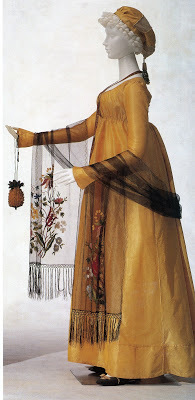 Susan reporting:
Susan reporting:This past weekend, Jane Austen fans from around the country (and a few from overseas as well) gathered in Louisville, KY for the Jane Austen Society of North America's annual Jane Austen Festival. Nearly all of the participants dress in splendid replicas of the era that they've created themselves, and from the images all over the internet, it's quite a Regency-era fashion show. (On Instagram, the hashtag #janeaustenfestival will lead you down a wonderful rabbit-hole.)
In the spirit of all those beautifully clad ladies - and maybe a hussy or two - I'm sharing this post again featuring the perfect accessory - including a link to directions for knitting one yourself.
As we've noted here before, the dramatic change in women's fashion in the late 18th and early 19th c not only meant the temporary end of wide skirts with hoops, but also the invention of a necessary new accessory: the purse. Gone were the days when a woman could tuck all her little necessities in an over sized pocket that tied around her waist and was hidden beneath voluminous petticoats. Much as purses are today, the new bags were often as stylish as they were utilitarian, and added a touch of bright color and whimsy to the ubiquitous white muslin gowns.
Many of you mavens of historic dress will recognize the picture of the gown, left. It has appeared in several of the excellent fashion books featuring the holdings of the Kyoto Costume Institute, and is all over fashion history blogs and pages on Pinterest.
The gown is French, c 1800, of silk taffeta with a drawstring waist. The shawl is silk net with an embroidered floral motif and silk fringe, and the hat is also silk net and pongee with a tassel.
But it's the pineapple dangling from the lady's wrist that has always intrigued me. Little bags like this were called reticules, from the French and earlier Latin for a small net or mesh bag. (There's another charming, if unsubstantiated, explanation that the word is a mocking derivative from ridicule, the French word for ridiculous.) Pineapples and other exotic fruit had become a fashion-forward motif thanks to the trendsetting Josephine de Beauharnais Bonaparte, born on the Caribbean island of Martinique. This pineapple-shaped reticule was knitted in yellow and green silk with silver beads for accents, and the top with the leaves pulls open with the tasseled drawstrings. It's a wonderful, witty example of three-dimensional knitting, whether the skilled workmanship of a professional knitter or a dedicated lady.
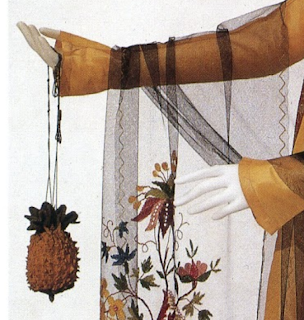
For a zoomable view of the bag on the Kyoto web site, click here .
The fashion for knitted and crocheted pineapples outlived Napoleon, with directions or "recipes" for them appearing in lady's magazines well into the mid-19th century. One version of the "Pine Apple Bag" appeared in The Lady's Assistant, for executing useful and fancy designs in knitting, netting, and crochetwork, published by Mrs. Jane Gaugain in 1840. Contemporary needleworker/blogger Isabel Gancedo has adapted this pattern for modern knitters, and posted both her version and Mrs. Gaugain's on her website here . Be forewarned: this is a challenging pattern for experienced knitters – but if you're game, the results are delightful!
Above: Photo from Revolution in Fashion 1715-1815, copyright 1990 The Kyoto Costume Institute
Many thanks to Janea Whitacre for pointing me towards Ms. Gancedo's on-line instructions.
Published on July 17, 2018 14:28
July 15, 2018
Baron de Berenger—Horse Whisperer?
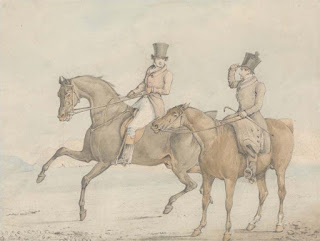 Thomas Alken, A Gentleman Riding With a Groom, and Coversing
Loretta report:
Thomas Alken, A Gentleman Riding With a Groom, and Coversing
Loretta report:Last year, during my visit to the Kensington Central Library, Dave Walker introduced me to the Baron de Berenger’s gun . Thanks to Dave's introducing me to this colorful character, I’ve spent some time with de Berenger’s Helps and Hints: How to Protect Life and Property . It surprised me in a number of ways.
At the time of my stories, animals tended to be treated brutally. I won’t go into the ugly details, but, generally speaking (of course there were many exceptions) if human life was cheap, non-human life was close to worthless, the RSPCA notwithstanding. And while life was kinder to humans of the privileged classes, they were not necessarily kinder to their animals, especially their horses. And so I was struck with de Berenger’s views on the subject:
“[A] rider should, to appearance at least, be a part of his horse; in the efforts of both these component parts there should seem as if there was but one and the same impulse,— a generous and reciprocal attention to please,—to serve, and to spare; and when that is accomplished, most horses will display as much delight in being rode, as the rider will be delighted in riding such a horse; but to accomplish this to perfection, an intimacy, nay, an affection, must be established between yourself and the generous animal; but which ... cannot be attained by the intercourse which, by far too generally, prevails between fashionable characters and their horses; these poor, willing, and faithful animals, rarely experiencing any other notice, save that of being urged on by whip and spur, to exertions but too frequently woefully distressing to a willing frame ... What has secured to the dog the reputation of being more affectionate, more intelligent, and more faithful, than the horse? Because, even the exquisite will deign to hold a familiar and encouraging intercourse, nay, conversation, with him: not so with the poor horse; except when being cleaned or fed, it stands unnoticed for many hours in dull solitude, at least as far as man is concerned. With him the cheering influence and the enjoyments of the sun are embittered by a portion of severe, because generally inconsiderate, labour; even then, and although enduring willingly, hardly ever to experience the pattings of a condescending hand as a cheap encouragement! ... nevertheless, and aware as the horse must be that it is led forth to endure straining labour, we see him cheerfully leave the stable, ever as willing slavishly to serve his master, as to please him, in any way, which he is taught to know as agreeable to him. Only familiarize with and pet him, as much as you do the dog, and his best endeavours at least to rival canine affection, intelligence, and fidelity, will soon be placed beyond all doubt.
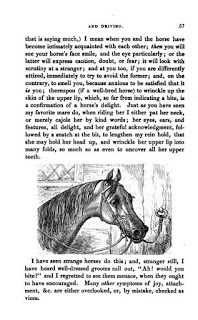 The entire entry, from which I’ve also included a clipping (at right), is well worth reading. I’d be especially interested in the reactions of our horse-loving/riding/driving Nerdy History persons.
The entire entry, from which I’ve also included a clipping (at right), is well worth reading. I’d be especially interested in the reactions of our horse-loving/riding/driving Nerdy History persons. Image: Henry Thomas Alken, A Gentleman Riding With a Groom, and Conversing (undated), courtesy Yale Center for British Art, Paul Mellon Collection.
Published on July 15, 2018 21:30
July 14, 2018
Breakfast Links: Week of July 9, 2018
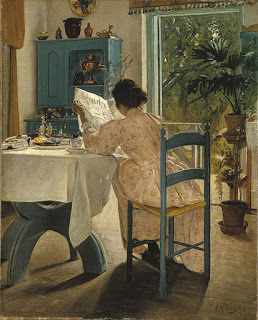 Breakfast Links are served! Our weekly round-up of favorite links to other web sites, articles, blogs, and images via Twitter.
Breakfast Links are served! Our weekly round-up of favorite links to other web sites, articles, blogs, and images via Twitter.• The 1802 Summer Exhibition of the Royal Academy faced unexpected competition from the wax figures of Marie Tussaud .
• Gin shops in the Regency: the "blue ruin" before hipsters discovered it.
• When reading inspired women to change history.
• How 18th-19thc literary women like Mary Robinson and Elizabeth Barrett Browning embraced opiates.
• The accidental Pied Piper of cats in 1909 New York.
• Video: Rotating jeweled flowers on this 18thc clock (sound up!)
• The 1866 wedding fashions in the painting The Hesitant Fiancee by Auguste Toulmouche.
• The link between women , witchcraft, and stirring.
• Pearls for the bride: a magnificent 1830s pearl parure.
• Cimitero delle Fontanelle and the Neapolitan cult of the dead .
• Image: "Touch watch" owned by author Helen Keller.
• Napoleon's pleasure-loving sister Pauline Bonaparte .
• A short history of tennis fashions .
• When butter was a food group: food and freedom in World War Two.
• The eagle as the ideal ruler, from ancient times to the Founding Fathers.
• Image: An aerial view of Hyde Park Fair on the day of Queen Victoria's coronation , June 28, 1838.
• A recipe for an unusual - and very potent - 18thc cocktail: King Calli's Spruce Beer .
• A brief history of the American Pledge of Allegiance .
• Ruth Wakefield is the name and the place behind legendary chocolate chip Toll House Cookies.
• How to live like an 11thc prince .
Hungry for more? Follow us on Twitter @2nerdyhistgirls for fresh updates daily.
Above: At Breakfast by Laurits Andersen Ring. Private collection.
Published on July 14, 2018 14:00
July 12, 2018
Friday Video: 18th Century Dining
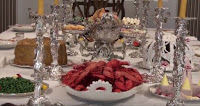 Loretta reports:
Loretta reports:As I’ve pointed out in a previous blog post, the dinner table of the late 1700s and early 1800s looked very different from our own, with a large number of dishes, both sweet and savory, presented at the same time.
This video gives a nice, three-dimensional view of what was on the table, as well as short explanations of the dishes. Also, I think you'll enjoy curator Ivan Day’s dry wit.
If the macaroni and cheese surprises you (as it did some commenters), you might want to check out Susan’s blog post on the subject . Also, as she explains in this blog post , the governor of Virginia would have been eating in the same fashion as his aristocratic counterparts in London.
YouTube Video: English Taste: The Art of Dining in 18th Century England with curator Ivan Day
Image is a still from the video.
Readers who receive our blog via email might see a rectangle, square, or nothing where the video ought to be. To watch the video, please click on the title to this post (which will take you to our blog) or the video title (which will take you to YouTube).
Published on July 12, 2018 21:30
July 11, 2018
A Letter from Angelica Schuyler Church on the Morning of the Hamilton-Burr Duel, July 11, 1804
 Susan reporting,
Susan reporting,You didn't really think I'd let the 214th anniversary of the duel between Alexander Hamilton and Aaron Burr pass unnoticed, did you? Especially since July 11, 2018 also falls on a Wednesday, just as it did in 1804. I've already written a post here about the duel itself. This one is about how, within hours of the duel, the first ripples of shock and grief are already beginning to spread through a close-knit family that would never again be the same.
There's nothing quite like an original letter from the past. The majority of surviving letters related to Alexander Hamilton, his wife Eliza Schuyler Hamilton, and her family have been transcribed and are available online on various sites. There's no doubt that this is convenient. It's much easier to read a modern transcription than to decipher the often-faded handwriting of long ago, with its dips and swirls and often-idiosyncratic spelling and punctuation. It also helps protect the originals from the wear and tear of being removed from preservation storage for repeated study.
But....
There's so much more to be learned from a handwritten letter than the words alone. Handwriting can reveal the writer's emotions, fears, and wishes, the urgency with which she or he wrote, or the care they took in choosing just the right word or phrase. I can't think of a better example than the letter above. (Please click to enlarge, and my apologies for the unavoidable reflections.)
The author of this letter was Angelica Schuyler Church, the eldest sister of Eliza Schuyler Hamilton, the wife of John Barker Church, and the sister-in-law to Alexander Hamilton. Angelica was a well-read, well-traveled, and well-educated 18thc woman, and many of her surviving letters are filled with ideas and thoughts, descriptions of where she has visited and whom she has met, and, depending on her correspondent, often a dollop of flirtation as well. But not here.
Angelica wrote this letter on the morning of July 11, 1804, shortly after Alexander had been rowed back across the Hudson River from New Jersey, where the duel had taken place, to New York City. The duel with Aaron Burr had gone disastrously wrong, and had left Alexander gravely injured. But when Angelica wrote this letter to her younger brother Philip Jeremiah Schuyler in Albany, she had clearly just arrived at the house of Alexander's friend William Bayard, where the injured Alexander had been brought. Given the severity of his wound and the amount of blood he'd already lost, it's hard to understand her optimism for his recovery, but perhaps the attending physician was putting the best face on the situation for Angelica and her sister Eliza, who is also already at her dying husband's bedside.
Or perhaps Angelica did know. The letter was clearly written in haste and anxiety, the words dashed across the page. The two passages that she underlined - wretch Burr and expression of grief - are probably the most revealing ones in the entire letter. And because we know what happened after the letter was written, they're also among the saddest.
Here's a transcription:
at Mr. Bayards Greenwich
Wednesday Morn July 11, 1804
My dear Brother, I have the painful task to inform you that General Hamilton was this morning wounded by that wretch Burr, And we have every reason to hope that he will recover. May I advise that you repair immediately to my father as perhaps he may wish to come down. My dear sister bears with saintlike fortitude this affliction. The Town is in consternation, and there exists only the expression of Grief & Indignation. Adieu my dear Brother. Remember me to Sally. Ever Yours,
A. Church
This letter belongs to The Gilder Lehrman Institute of American History, and is currently on loan and on display in the exhibition Hamilton: The Constitutional Clashes That Shaped a Nation at the National Constitution Center in Philadelphia, PA. The exhibition runs until December 31, 2018; see here for more information. Many thanks to Jessie Serfilippi of the Schuyler Mansion for her assistance with this post.
Read more about Eliza Schuyler and Alexander Hamilton in my latest historical novel, I, Eliza Hamilton, now available everywhere.
Published on July 11, 2018 17:00
July 9, 2018
Fashions for July 1875
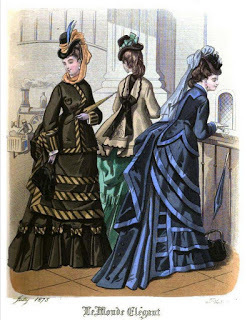 Travel & Promenade Dress July 1875
Loretta reports:
Travel & Promenade Dress July 1875
Loretta reports:For a perspective on this month’s fashion plate, I offer a quote from Jane Ashelford’s The Art of Dress .
“A narrower silhouette appeared in 1874, introducing a sheath-like bodice which fitted over the waist and hips, thus necessitating a new style of corset. The flat effect down the front of the skirt was further enhanced by tapes inside the skirt which pulled it closer to the body. In conjunction with this tightening of the silhouette, the bustle grew smaller and was positioned lower down, where the fullness of the skirt extended into a long train.”
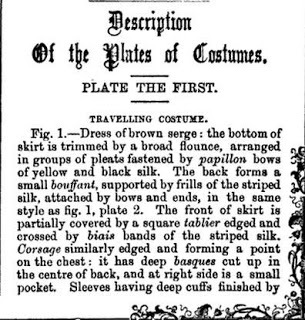 Travel & Promenade Dress Description
Travel & Promenade Dress Description
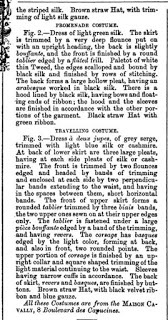 Description cont'd
Description cont'd
Published on July 09, 2018 21:30
July 8, 2018
A Bold & Forthright Kiss, c1780
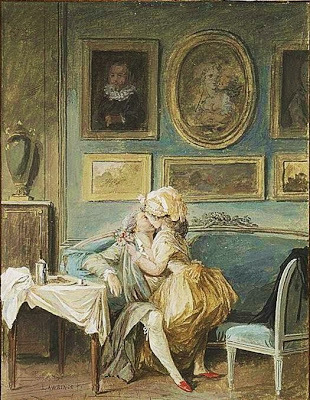 Susan reporting,
Susan reporting,Last week, I shared this unusually intimate 18thc painting on my Instagram and Facebook pages in honor of the hashtag #InternationalKissingDay. The painting has long been one of my favorites, and I've been thinking of all the other things I'd wished to say about it that didn't fit in a short caption. So here are those thoughts, along with the painting itself for those of you who didn't see it last week.
The majority of kisses in 18thc Western art of the "stolen kiss" variety (like this .) In the past, the women in stolen kiss themes were considered coy, or making la feinte resistance (a false resistance), or in mid-20thc parlance, just "playing hard to get." Today it's difficult to look at pictures like that and not think about the Me Too movement, and how often the man is shown aggressively forcing himself on a woman who'd much rather be saying no, but can't.
The artist of this watercolor is Nicolas Lavreince - also Lawreince and Lavrince - (1737-1807), a Swedish painter whose work was heavily influenced by the French rococo style of Nicolas Pater and Jean-Honore Fragonard. Most of his paintings are cheerfully gallant scenes of boudoirs and bedrooms showing pretty young women with their lovers, though he had his sleazy, queasy side, too (like this .)
All of which makes this painting the more unusual. Here, the woman is clearly the one in control. She appears to have interrupted the gentleman at his breakfast. He's wearing an open banyan or robe de chambre over his shirt and breeches with mules on his feet - the 18thc equivalent of a robe and slippers - to show he's likely just risen from his bed. The table is set for him alone, with only one plate and cup.
The lady, however, is fully dressed for day, in a stylish gown, kerchief, cap, and stays. She appears to have just arrived, since her dark cloak is tossed over the back of the chair. She's clutching a small nosegay of flowers; has she brought that to him? There's clearly a sense of surprise, as if she's the one who's caught him in his male version of a boudoir. Here he was, quietly eating his solitary breakfast, when all of a sudden this young woman is HERE, sitting on his knee and shoving open his shirt and banyan and kissing him. It's quite the ambush - not that he objects. His hand curled around her hip to hold her steady on his thigh proves that. And if there's any doubt that this is intended to be a reversal of more customary scenes, the sketchy oval painting on the wall shows a traditional couple with the man reaching from behind the woman to kiss her and cradle her breasts.
Some art historians believe that this shows an encounter between a gentleman and a prostitute, arguing that the only possible explanation for the woman being so forthright in her desire is that she's being paid to do so. I'd rather think that, in this case, turnabout was fair play.
Le déjeuner en tête à tête by Nicolas Lawreince le Jeune, c1780, Musee Louvre.
Published on July 08, 2018 17:00
June 25, 2018
Gone Typin'
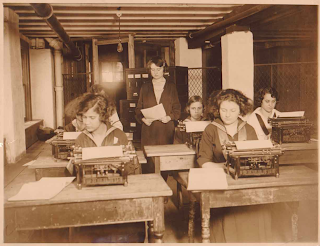 It's summertime, the time of year when we usually pack up the blog for vacation and go fishin'.
It's summertime, the time of year when we usually pack up the blog for vacation and go fishin'.But this year, we're spending these beautiful June days at our keyboards, typin', not fishin'. While our working conditions aren't nearly as grim as this, we do have to concentrate on our books for a bit instead of blogging.
Look for fresh posts after Independence Day!
Early 20thc photograph from The Virtual Typewriter Museum.
Published on June 25, 2018 21:00
June 24, 2018
Shameless Self-Promotion: A Pair of Upcoming Events Featuring I, ELIZA HAMILTON
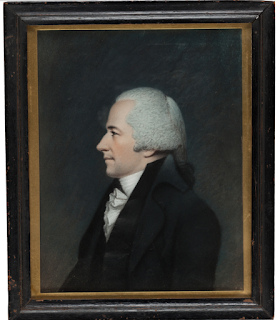 Susan reporting,
Susan reporting,July seems to have become the unofficial month to honor Alexander Hamilton: statesman, soldier, hero of the American Revolution, signer of the Constitution, first Secretary of the Treasury, founder of America's financial system, the United States Mint, the Federalist Party, the Coast Guard, two banks, and a newspaper - and he was the husband of Eliza Schuyler Hamilton, the heroine of my current historical novel, I, Eliza Hamilton. (He's also "Ten Dollar Founding Father" on the ten dollar bill, and the star of the award-winning Broadway show that bears his name; John Adams would be sick with envy.)
But until Lin-Manuel Miranda put Hamilton's life to music several years ago, what most people knew about Hamilton was that he was shot in a duel by then-Vice President Aaron Burr. (Read more about that tragic event in my blog posts here, here, and here.) The duel took place on July 11, 1804, and Hamilton died the following day. For better or worse, this is the reason for July being "Hamilton Month" - and with that in mind, I'll be participating in two events that will focus less on Alexander, and more on his wife Eliza.
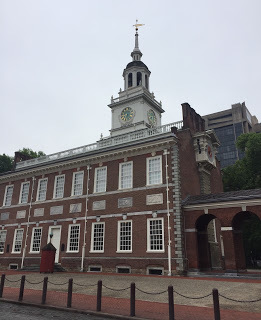
On Thursday, July 12, 6:00-7:30 pm, I'll be the guest of the Friends of Independence National Historical Park in Philadelphia. I'll be speaking about Eliza and Alexander and how I came to write Eliza's story in the Benjamin Franklin Museum - only a few blocks away from where the Hamiltons lived while Alexander was serving in the new Federal government. We'll share a toast in honor of Alexander (not you, Colonel Burr), and I'll be signing copies of I, Eliza Hamilton as well. The talk will benefit the Friends of INHP. See here for more information and for tickets.
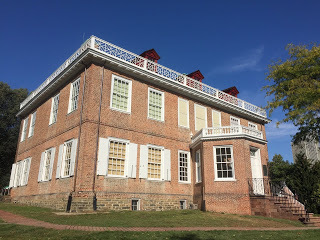
And on Saturday, July 14, 3:00-5:30 pm, I'll be part of the Schuyler Sisters Book Slam, hosted by the historic Schuyler Mansion (the beautifully restored and furnished 18thc home of the Schuyler family, and the site of Eliza's wedding to Alexander) in Albany, NY. I'll be discussing my research about Eliza that inspired I, Eliza Hamilton. Also participating will be author and scholar Danielle Funiciello, who will share her research regarding the oldest Schuyler sister, Angelica Schuyler Church. Rounding out the program will be L.M. Elliot, author of the young adult historical novel Hamilton and Peggy!, who will discuss the third Schuyler sister, Margarita "Peggy" Schuyler Van Rensselaer. A reception and booksigning will follow. Check the Mansion's Facebook page for more information as soon as it is available.
Hope to see you there!
Top left: Alexander Hamilton by James Sharples, c1796, New York Historical Society.
Right: Independence Hall, Philadelphia, PA.
Lower left: Schuyler Mansion, Albany, NY.
All photos by Susan Holloway Scott.
Published on June 24, 2018 17:43
June 23, 2018
Breakfast Links: Week of June 18, 2018
 Breakfast Links are served! Our weekly round-up of favorite links to other web sites, articles, blogs, and images via Twitter.
Breakfast Links are served! Our weekly round-up of favorite links to other web sites, articles, blogs, and images via Twitter.• Adelaide Hermann , 19thc Queen of Magic: she caught bullets with her bare hands, and made magic's glass ceiling disappear..
• The poignant, richly creative life of poet John Keats , evoked through a visit to his house.
• Jefferson's Monticello finally gives Sally Hemings her place in presidential history.
• A 17thc tailor tempted by dancing: a page in the life of John Dane .
• Image: Hidden in the inside cover of this book, a 19thc hand-written witticism that's still funny.
• How women "got married" long before gay marriage.
• A page worth exploring: Music of the American Civil War .
• A football match in 18thc Ireland.
• Once freed from enslavement, Moses Williams became a master silhouette artist in 18th-19thc Philadelphia.
• The surprising origin of the word morgue .
• How to spot a perfect fake: James Martin, the world's top art forgery detective .
• Sex, lies, and betrayal : did Wordsworth really betray Coleridge?
• The "romance" of Grace and Calvin Coolidge .
• Image: Twinkle toes: rhinestone-set shoe epitomizes fashion's taste for sparkle after Stock Market Crash of 1929.
• Not just in Boston: New York City's Patriots and the 1774 Tea Party .
• The workings of the Ladies' Aid Societies of the American Civil War.
• The history of the lead pencil .
• What the sailors ate on board Captain Cook's Resolution, 1775.
Hungry for more? Follow us on Twitter @2nerdyhistgirls for fresh updates daily.
Above: At Breakfast by Laurits Andersen Ring. Private collection.
Published on June 23, 2018 14:00



